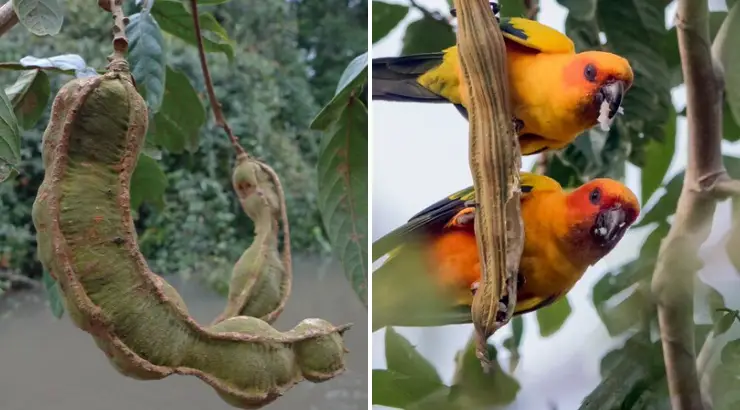Good News
Destruction of the Amazon Could Be Prevented by This Ice-Cream-Flavored “Miracle Tree”
Experts say the inga tree could help slow or even stop deforestation in the sensitive Amazon region.

(TMU) — While the Amazon continues to plummet toward its destruction amid historic wildfires and a frenzied pace of deforestation driven by agricultural land clearances, some experts are claiming that a certain tree species could keep the soil of the Amazon fertile enough to keep the region somewhat healthy.
The inga tree, also known as ice-cream bean trees due to its vanilla-tasting pulp, could help slow or even stop deforestation in the sensitive Amazon region, reports the BBC.
Not only is the inga tree capable of growing on the poor soil left in the wake of destructive slash-and-burn land clearing methods, but it can also fix the nitrogen in the soil—potentially making it fertile enough for native species to return.
The beans from the inga tree can also be used to feed livestock while the trees can be used as wood fuel, giving small farmers an incentive not to sell their lots to major agribusiness while helping to address the dire problem of poverty in the Amazon.
The trees, which belong to the legume family, have become the basis for a new project by the Ouro Verde (Green Gold) Institute, which researchers hope can supplement farmers’ income while also maintaining the fragile biodiversity in the troubled region.
?? Known for producing 'ice cream beans', Inga trees are a familiar sight across Colombia. But, in addition to their vanilla tasting fruit pulp, they have many uses: https://t.co/Il4PC42R2Y pic.twitter.com/RnDbh8Y8mz
— Kew Science #SOTWPF ?? (@KewScience) September 1, 2019
University of Exeter professor of tropical plant diversity and biogeography Toby Pennington told the BBC:
“It’s very much a kind of ‘miracle tree’ or a super tree because some of the species can do some amazing things.
They can grow really fast on very, very poor soils, even soils where a rainforest has been cut down and have become very degraded.
But even amongst legumes, they have pretty fantastic growth rates.
More than that, these species have fruits that are edible and often have local markets right across Latin America.”
In addition to helping fix the atmospheric nitrogen in the soil, the plants can also provide cover over land, helping create diverse wildlife corridors throughout the increasingly fractured Amazon region.
Sun parakeets feeding on seed pods of the ice-cream bean tree (Inga edulis), Boa Vista, Roraima state, northern Brazil #ParrotOTD. Pic by Jorge D. Pavani via @wikiaves https://t.co/IAgvR5DS5U pic.twitter.com/0jdhD72JWu
— Parrot Of The Day ? (@ParrotOfTheDay) August 12, 2019
The Inga Foundation also claims that the trees would “provide soil protection, weed control and a nutrient regime.”
Dr. Saulo de Souza of the Ouro Verde Institute explained:
“These plantations would favor wildlife that could use them as habitats or as stepping stones to move between forest remnants.
By fixing carbon, tree growth in pastures could reduce the ecological footprint of dairy cattle.
The trees could also increase soil permeability, granting higher loads to the water table and reducing soil erosion.”
Yet any attempts to re-green the Amazon would require simultaneous efforts to halt the rampant destruction of the rainforest.
Last week the Mind Unleashed reported that Monica de Bolle, a senior fellow at the Washington D.C.-based Peterson Institute for International Economics (PIEE), warned that the Amazon is being rapidly pushed toward an irreversible “tipping point” that could be reached within two years.
Once the Amazon passes this point, the rainforest would cease to be able to produce its own rain—a crucial part of its ability to sustain itself—and it would degrade into dry savannah and grasslands, releasing enormous amounts of carbon emissions into the atmosphere, disrupting weather patterns across South America, and sending global heating through the roof.
In the meantime, fires have increased by a stunning 84 percent since the same period last year. Deforestation rates between January and August 2019 have also doubled versus the prior year, according to Brazil’s National Institute for Space Research, mainly due to the actions of arsonists serving agribusiness and cattle-ranching oligarchs.
Brazilian human rights activist Maria Luísa Mendonça says Jair Bolsonaro, like Donald Trump, does not believe in climate change. That helped lead to the unprecedented fires in the Amazon, she says. "Bolsonaro gave a green light for illegal deforestation of the Amazon." pic.twitter.com/ArYOluvHwV
— Democracy Now! (@democracynow) August 28, 2019
Since coming to office, the radically right-wing President Bolsonaro has encouraged the illegal deforestation of the Amazon through a combination of a hostile attitude toward environmental regulations and genocidal rhetoric toward indigenous groups whose ancestral land lies in the rainforests.
Bolsonaro and his officials regularly blame environmental laws, activist groups, non-governmental organizations, and indigenous peoples for allegedly hindering Brazil’s economic potential.
By Elias Marat | Creative Commons | TheMindUnleashed.com
Typos, corrections and/or news tips? Email us at Contact@TheMindUnleashed.com
